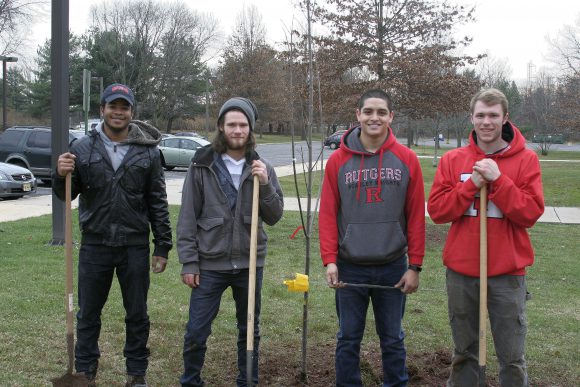
Students left to right: Levon Bigelow, Riley Eddins, James Diaz, Jordan Glaser.
Urban forestry is a relatively new discipline, full of new ideas and opportunities to innovate. The need for highly trained, qualified professionals in this industry is growing quickly as more and more people begin to realize the extent of the benefits that the urban forest provides, as well as the complexity of managing this resource.
Rutgers offers an urban forestry major option through the Environmental Planning and Design major in the Department of Landscape Architecture. Also offered is an Urban Forestry Certificate through the Department of Ecology, Evolution, and Natural Resources.
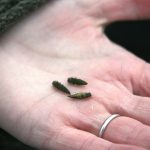
Emerald Ash Borer.
In December the Program held an open air open house where participants saw and participated in the proactive management program for Emerald Ash Borer (Agrilus planipennis Fairmaire) on campus. This exotic, invasive beetle was discovered in Michigan in 2002 and will eventually spread to all ash trees in the United States, making the trees dangerous and presenting an enormous problem for urban and suburban communities throughout the country.
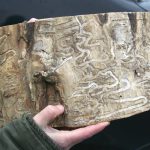
Destructive tunnels made by the Emerald Ash Borer.
This pest, however, has provided students with the ideal hands-on learning opportunity, a silver lining in an otherwise terrible situation. Not only do these trees need to be taken down due to safety concerns, but they also need to be replaced in a timely fashion. Trees provide numerous benefits to communities, including pollution mitigation, the reduction of heating and cooling costs and storm water management. This is of particular significance in urban areas with a lot of non-permeable surfaces such as parking lots. Without these trees, flooding would increase significantly. Trees also increase property values and are a beautiful addition to the urban environment.
The outdoor classroom was located in lot 99C, parking for Cook Student Center. On a chilly December afternoon Rick Yoos from Yoos Crane Service used a whole tree harvester to remove an ash tree as the first step in the University’s larger plan to remove and replace campus ash trees.
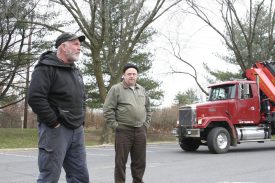
Rick Yoos, Yoos Crane Service, and Jason Grabosky, professor and urban forestry program director.
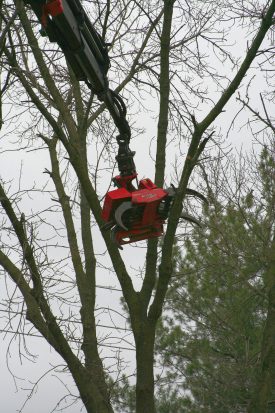 This unusual crane has the flexibility and strength to trim a large tree down significantly before sectioning the trunk and removing the rest of the tree. And because it can be operated remotely, no one needs to be in the tree to take it down. This is significant as many of the ash trees that have been affected will be brittle and would therefore put climbers at risk. “This is a great piece of equipment,” said Yoos. “And if you like being outdoors and love trees, then there is no better job in the world.” Yoos explained that a lot of his business involved pruning and saving trees.
This unusual crane has the flexibility and strength to trim a large tree down significantly before sectioning the trunk and removing the rest of the tree. And because it can be operated remotely, no one needs to be in the tree to take it down. This is significant as many of the ash trees that have been affected will be brittle and would therefore put climbers at risk. “This is a great piece of equipment,” said Yoos. “And if you like being outdoors and love trees, then there is no better job in the world.” Yoos explained that a lot of his business involved pruning and saving trees.
Stephanie Murphy, lab support specialist from the Rutgers Soil Testing Lab then took students to conduct a soil testing demonstration in preparation for replanting efforts. It’s important to know the soil you have in order to know what type of tree with which to replace these ash trees. Knowing the composition of the soil also informs the type of nutrients that will be used to ensure the seedlings grow into healthy trees.
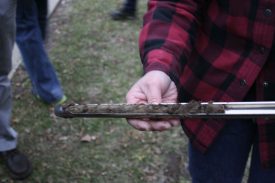 Taking a soil sample is a critical step in the process of soil analysis. If a soil sample is not properly done, the analytical results will be poor, and may actually result in recommendations that are detrimental to the plants’ growth.
Taking a soil sample is a critical step in the process of soil analysis. If a soil sample is not properly done, the analytical results will be poor, and may actually result in recommendations that are detrimental to the plants’ growth.
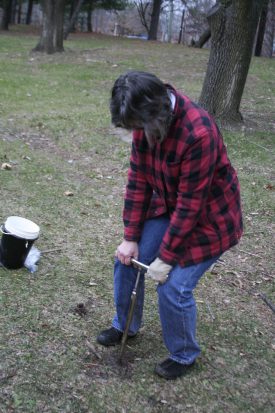 Students broke into teams and using soil tubes—also known as augers—took between 10 and 15 samples of soil from the surface to a depth of six to seven inches throughout the various areas where the seedlings would be planted and placed all sub-samples together in a clean bucket.
Students broke into teams and using soil tubes—also known as augers—took between 10 and 15 samples of soil from the surface to a depth of six to seven inches throughout the various areas where the seedlings would be planted and placed all sub-samples together in a clean bucket.
After the soil was analyzed, students and facilities staff reconvened the following week to plant the transplants that were donated by Mickey Riggin of Arbor Care Resources.
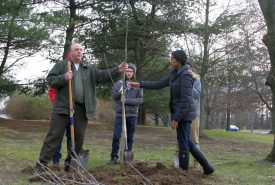
Left to right professor Jason Grabosky and students Riley Eddins and Yashoda Nukala.
Jason Grabosky, professor and urban forestry program director, then instructed everyone on the proper method of planting bare root transplants, from root care to hole diameter and depth to how to pack the soil and water requirements. Teams of two to three then commenced planting the entire area. These transplants will be well-established by the time all of the ash trees have to be removed.
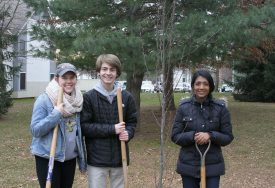
Left to right students Emily Conway, Casey Hamilton and Yashoda Nukala.
As more people move to urban areas—as has been the trend for approximately 10 years—urban forests will continue to serve an ever greater purpose and the need to care for these resources be become increasingly important. The U.S. Bureau of Labor Statistics projected that the number of jobs for foresters would increase 7% nationwide between 2014 and 2024.
The urban/community forest is where trees and people meet. However, trees are not native to the urban environment. In order for our urban and community forests to truly thrive, and in order to maximize the positive ecosystem services they provide, they must be properly planned, maintained, and managed.
If you have any questions, or think you may be interested in urban/community forestry as a career, please contact us: Dr. Jason Grabosky grabosky@sebs.rutgers.edu, 848-932-0050.

